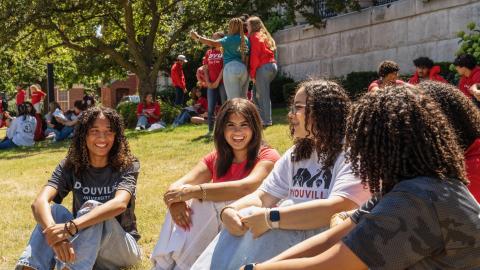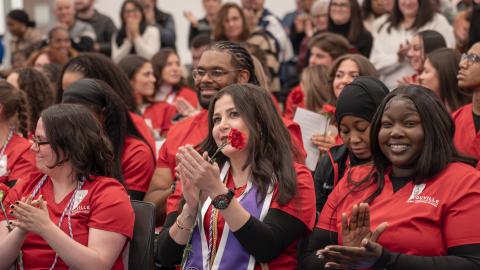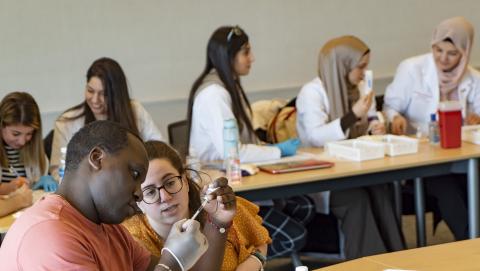
Progress Without Equity (Second Study)
D'Youville Professor Co-Authors Second Study in the "Progress Without Equity" Research Series Revealing that Girls' Share of Interscholastic Sports Opportunities Has Declined Over the Past Decade
Ann Arbor, Michigan – October 8, 2012 – While girls' share of high school athletic participation opportunities increased between 1993-1994 and 1999-2000, progress toward gender equity slowed and, perhaps, even reversed direction during the past 11 years, a newly released report by the Sport, Health and Activity Research and Policy Center for Women and Girls (SHARP Center), indicated.
The SHARP Center, a University of Michigan and Women's Sports Foundation (WSF) collaboration released its latest research report, providing valuable insight into the state of high school athletics and the inequalities that still exist in the U.S. public school system, despite the passing of the landmark legislation, Title IX, 40 years ago.
"The Decade of Decline: Gender Equity in High School Sports," a study co-authored by Don Sabo, Ph.D., Director, Center for Research on Physical Activity, Sports & Health (CRPASH), D'Youville College and SHARP Director, and Philip Veliz, Ph.D., Post-Doctoral Fellow, University of Michigan, analyzes data from the Department of Education's Office for Civil Rights (OCR) Data Collection on girls' and boys' high school athletic opportunities between the 1999-2000 and 2009-10 school years.
Key findings from "The Decade of Decline: Gender Equity in High School Sports" include:
• Athletic participation opportunities expanded across the decade, but boys' allotment grew more than girls. By 2009-10, 53 athletic opportunities were offered for every 100 boys, compared with 41 opportunities for every 100 girls.
• Despite the level of economic resources, the opportunity gap between girls and boys continued to increase. By 2010 girls participated in greater numbers than in the beginning of the decade; however, girls' share of total athletic opportunities decreased across the decade as compared to boys' share. During a decade of expanding athletic participation opportunities across U.S. high schools, boys received more opportunities than girls, and boys' opportunities grew faster than those of girls.
• By 2009-10 boys still received disproportionately more athletic opportunities than girls in all community settings—urban, suburban, towns, and rural communities.
• In 2000, 8.2 percent of schools offered no sports programs, the percentage nearly doubled by 2010, rising to approximately 15 percent. Additionally, schools with disproportionately higher female enrollments (i.e., the student body is 56 percent female or higher) were more likely to have dropped interscholastic sports between 2000 and 2010.
• Seven percent of public schools lost sports programs between 2000 and 2010, while less than one percent added sports to their curriculum. Given this trend in the data, it is estimated that by the year 2020, 27 percent of U.S. public high schools (4,398 schools) would be without any interscholastic sports, translating to an estimated 3.4 million young Americans (1,658,046 girls and 1,798,782 boys) who would not have any school-based sports activities to participate in by 2020 if the trend continues.
"In the wake of the 2012 London Olympic and Paralympic Games, the state of women's sports in the U.S. has generated great praise, and many believe that girls and women have finally achieved athletic equality. However, these findings suggest that we simply aren't there yet. In fact, we are moving farther and farther away from equality with the cutting of interscholastic sports," expressed Kathryn Olson, Chief Executive Officer of the Women's Sports Foundation. "It goes beyond the physical benefits of sport. Sports are an integral part of the educational experience; students who participate in sports are shown to achieve greater academic success. The decline of interscholastic athletic opportunities should be looked at as an erosion of the educational capacity."
"One of the priorities of the SHARP Center is to uncover trends in access to participation opportunities in sport and physical activities for women and girls," said Kathy Babiak, SHARP co-director and associate professor of sport management at the University of Michigan's School of Kinesiology. "SHARP's Decade of Decline report demonstrates through a rigorous analysis of longitudinal data that inequities still exist in opportunities and access to sport for girls in high school.
"The matter of equity for girls in sport is of significant importance, and the SHARP Center will continue to work on this area in the future. We intend use our findings to support policy and advocacy to enhance access to sport and physical activity for women and girls."
Through this benchmark study, the SHARP Center hopes to inform and educate policy makers on the importance of ensuring that athletic opportunities are readily available to youth at the high school level. The Women's Sports Foundation worked with the National Women's Law Center (NWLC) to create relevant, evidence-based policy recommendations based on the report's findings:
• The Office for Civil Rights should strengthen its enforcement of Title IX in secondary schools to ensure that girls receive equal opportunities to reap the many valuable benefits of playing sports.
• Federal policymakers should require high schools to publicly disclose gender equity data about their athletics programs.
• Urban schools, in particular, should redouble their efforts to increase the numbers of athletic opportunities that they provide to girls.
• All schools should have Title IX coordinators and should regularly conduct Title IX self-evaluations to ensure that they are complying with the law.
For detailed results of "The Decade of Decline: Gender Equity in High School Sports" and to access the complete policy recommendations, please visit www.SHARPCenter.org.
About the Sport, Health and Activity Research and Policy Center for Women and Girls (SHARP)
SHARP, the Sport, Health and Activity Research and Policy Center for Women and Girls, was established in 2010 as a new partnership between the Women's Sports Foundation and University of Michigan's School of Kinesiology and Institute for Research on Women & Gender. SHARP's mission is to lead research that enhances the scope, experience, and sustainability of participation in sport, play, and movement for women and girls. Leveraging the research leadership of the University of Michigan with the policy and programming expertise of the Women's Sports Foundation, findings from SHARP research will better inform public engagement, advocacy, and implementation to enable more women and girls to be active, healthy, and successful.
Dr. Don Sabo may be reached at 716-829-8178 or 716-937-7522
PR Contacts:
Kevin Pchola
Women's Sports Foundation
(212) 299-8950
Kevin.Pchola@zenogroup.com
Jared Wadley
University of Michigan
(734) 936-7819
JWadley@umich.edu

